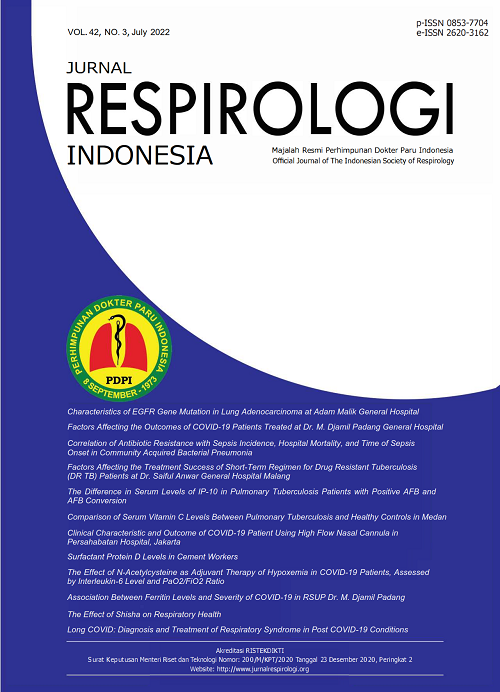The Difference in Serum Levels of IP-10 in Pulmonary Tuberculosis Patients with Positive AFB and AFB Conversion
DOI:
https://doi.org/10.36497/jri.v40i3.358Keywords:
AFB, IP-10, Pulmonary tuberculosisAbstract
Background: Tuberculosis (TB) is caused by Mycobacterium tuberculosis, which most commonly infects the lungs. Diagnostic modalities are required in smear-negative TB. IP-10 is a potent chemokine for detecting the presence of TB infection. This study aimed to determine the difference in serum IP-10 levels in patients with smear-positive pulmonary TB and pulmonary TB patients with AFB conversion after two months of therapy.
Methods: This was an analytic observational study with a cross-sectional approach. Sampling was carried out by consecutive sampling methods. AFB examination was performed using Ziehl-Neelsen staining, and serum IP-10 was measured using ELISA.
Results: The study results obtained mean IP-10 levels in TB patients with smear positive and AFB conversion after two months of treatment of 459 pg/mL and 204.4 pg/mL, respectively. Statistical analysis using independent t-test received P<0.0001. The optimal cut-off value was 306,1 pg/ml (90% sensitivity; 95% specificity; area under the curve: 0.948, 95% CI=0.88-1; P=0.0001).
Conclusion: There was a significant difference between IP-10 levels in TB patients with smear positive and AFB conversion
Downloads
References
World Health Organization. Tuberculosis [Internet]. World Health Organization. 2020 [cited 2020 Mar 25]. Available from: https://www.who.int/health-topics/tuberculosis#tab=tab_1
World Health Organization. Global tuberculosis report 2019 [Internet]. World Health Organization. Geneva; 2019. Available from: https://www.who.int/publications/i/item/9789241565714
Kementrian Kesehatan Republik Indonesia. Pusat Data dan Informasi Tuberculosis. Kementrian Kesehatan Republik Indonesia. 2018.
Metcalfe JZ, Everett CK, Steingart KR, Cattamanchi A, Huang L, Hopewell PC, et al. Interferon-γ release assays for active pulmonary tuberculosis diagnosis in adults in low-and middle-income countries: Systematic review and meta-analysis. J Infect Dis. 2011;204(SUPPL. 4):S1120–S1129.
Petrone L, Vanini V, Chiacchio T, Petruccioli E, Cuzzi G, Schininà V, et al. Evaluation of IP-10 in Quantiferon-Plus as biomarker for the diagnosis of latent tuberculosis infection. Tuberculosis (Edinb). 2018;111:147–53.
Tonby K, Ruhwald M, Kvale D, Dyrhol-Riise AM. IP-10 measured by Dry Plasma Spots as biomarker for therapy responses in Mycobacterium Tuberculosis infection. Sci Rep. 2015;5:1–6.
Guo SJ, Jia LQ, Hu QJ, Long HY, Pang CS, Wen FQ. Diagnostic accuracy of interferon gamma-induced protein 10 for tuberculosis: A meta-analysis. Int J Clin Exp Med. 2014;7(1):93–100.
Goletti D, Petruccioli E, Joosten SA, Ottenhoff THM. Tuberculosis biomarkers: From diagnosis to protection. Infect Dis Rep. 2016;8(2):24–32.
Petrone L, Cannas A, Aloi F, Nsubuga M, Sserumkuma J, Nazziwa RA, et al. Can blood or urine IP-10 discriminate between active and no active tuberculosis in children? 2015;2015:PA3635.
Ruhwald M, Ravn P. Biomarkers of latent TB infection. Expert Rev Respir Med. 2009;3(4):387–401.
Narumi S, Takeuchi T, Kobayashi Y, Konishi K. Serum levels of IFN-inducible protein-10 relating to the activity of systemic lupus erythematosus. Cytokine. 2000;12(10):1561–5.
Ragusa F, Fallahi P. IP-10 in occupational asthma: Review of the literature and case-control study. Clin Ter. 2017;168(2):151–7.
Liu M, Guo S, Hibbert JM, Jain V, Singh N, Wilson NO, et al. CXCL10/IP-10 in infectious diseases pathogenesis and potential therapeutic implications. Cytokine Growth Factor Rev. 2011;22(3):121–30.
Hong JY, Jung GS, Kim H, Kim YM, Lee HJ, Cho SN, et al. Efficacy of inducible protein 10 as a biomarker for the diagnosis of tuberculosis. Int J Infect Dis. 2012;16(12):e855–9.
Downloads
Additional Files
Published
Issue
Section
License
- The authors own the copyright of published articles. Nevertheless, Jurnal Respirologi Indonesia has the first-to-publish license for the publication material.
- Jurnal Respirologi Indonesia has the right to archive, change the format and republish published articles by presenting the authors’ names.
- Articles are published electronically for open access and online for educational, research, and archiving purposes. Jurnal Respirologi Indonesia is not responsible for any copyright issues that might emerge from using any article except for the previous three purposes.
















